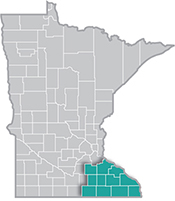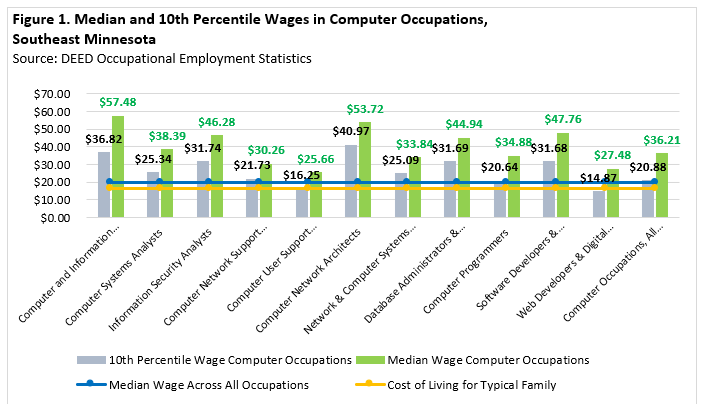 Southeast Minnesota is a health care and agricultural powerhouse. The region is home to the renowned Mayo Clinic and some of the world's most recognized food companies and brands.
Southeast Minnesota is a health care and agricultural powerhouse. The region is home to the renowned Mayo Clinic and some of the world's most recognized food companies and brands.
Advanced manufacturing is especially strong here, with machinery, chemicals, and electronics among the top products.
Want the freshest data delivered by email? Subscribe to our regional newsletters.
3/31/2021 9:00:00 AM
It seems that almost every job in today's world requires at least some knowledge of computers, whether it be working a cash register at the local fast food joint, operating a computerized manufacturing machine, or working as a Financial Manager at a business. Heck, even punching in and out of work is done via computer at many establishments. For many job seekers, increasing knowledge of computer operations could also lead to heightened job mobility, promotions and higher wages.
More specifically, there are also occupations that are focused on information technology and computer operations, such as Computer User Support Specialists and Software Developers. Southeast Minnesota has its fair share of these particular occupations. In fact, there are around 4,370 computer and information technology (IT) workers in the region, making up 1.8% of total regional employment.
Software Developers and Software Quality Assurance Analysts and Testers are the region's largest IT occupation, with 1,880 people employed in the region. Other large occupations include Computer User Support Specialists and Computer Systems Analysts with employment numbers of 530 and 380, respectively. Together, these three occupations make up just over two-thirds of the total IT employment in Southeast Minnesota. Also included in the regional employment are Computer and Information Systems Managers, which are part of the Management occupational group, and those account for 340 employed persons (see Table 1).
| Occupation | Employment | Wage Percentiles | ||||
|---|---|---|---|---|---|---|
| 10th | 25th | Median | 75th | 90th | ||
| Total, All Occupations | 242,490 | $11.35 | $14.07 | $19.89 | $30.81 | $44.27 |
| Management Occupations | 10,720 | $23.95 | $31.62 | $43.33 | $58.27 | $78.55 |
| Computer and Information Systems Managers | 340 | $36.82 | $45.85 | $57.48 | $71.98 | $87.84 |
| Computer and Mathematical Occupations | 4,170 | $22.75 | $29.75 | $40.34 | $52.09 | $66.46 |
| Software Developers & Software Quality Assurance Analysts & Testers | 1,880 | $31.68 | $39.50 | $47.76 | $60.34 | $79.51 |
| Computer User Support Specialists | 530 | $16.25 | $20.60 | $25.66 | $30.56 | $36.90 |
| Computer Systems Analysts | 380 | $25.34 | $31.84 | $38.39 | $47.75 | $58.01 |
| Network & Computer Systems Administrators | 270 | $25.09 | $28.46 | $33.84 | $41.71 | $49.75 |
| Computer Programmers | 260 | $20.64 | $23.25 | $34.88 | $48.61 | $60.44 |
| Computer Network Support Specialists | 220 | $21.73 | $26.14 | $30.26 | $36.13 | $41.63 |
| Computer Occupations, All Other | 140 | $20.88 | $27.03 | $36.21 | $48.84 | $60.76 |
| Web Developers & Digital Interface Designers | 110 | $14.87 | $23.27 | $27.48 | $31.90 | $47.25 |
| Information Security Analysts | 100 | $31.74 | $37.37 | $46.28 | $60.44 | $72.29 |
| Database Administrators & Architects | 80 | $31.69 | $36.00 | $44.94 | $57.19 | $68.25 |
| Computer Network Architects | 60 | $40.97 | $47.39 | $53.72 | $59.67 | $66.36 |
| Source: DEED Occupational Employment Statistics | ||||||
Traditionally, many computer occupations require post-secondary education, with most requiring at least a bachelor's degree. With this higher level of education also comes higher wages, as is shown in DEED's Occupational Employment Statistics wage percentile data. Median wages for these computer occupations are all above $25 per hour and range from $25.66 for Computer User Support Specialists to $57.48 for Computer and Information Systems Managers, which is nearly $120,000 per year for a full-time worker. In addition, 10th percentile wages are nothing to scoff at either, with hourly wages ranging between $14.87 to $40.97 (see Table 1 and Figure 1).

All of these computer occupations have median wages that are higher than the median wages across all occupations, as well as considerably higher than the hourly wage each parent in the typical Minnesota family would need to earn to meet the basic cost of living needs. For the most part, even the 10th percentile wages are also higher than both the median wages across all industries and the basic cost of living required wage, with only two occupations – Web Developers and Digital Interface Designers and Computer User Support Specialists – seeing 10th percentile wages below these two parameters (see Figure 1). Jobseekers with computer skills might be excited to see the high-paying opportunities available in the region.
April 2021 is Tech Month in Minnesota. Learn more at CareerForceMN.com/TechMonth.
Contact Mark Schultz.